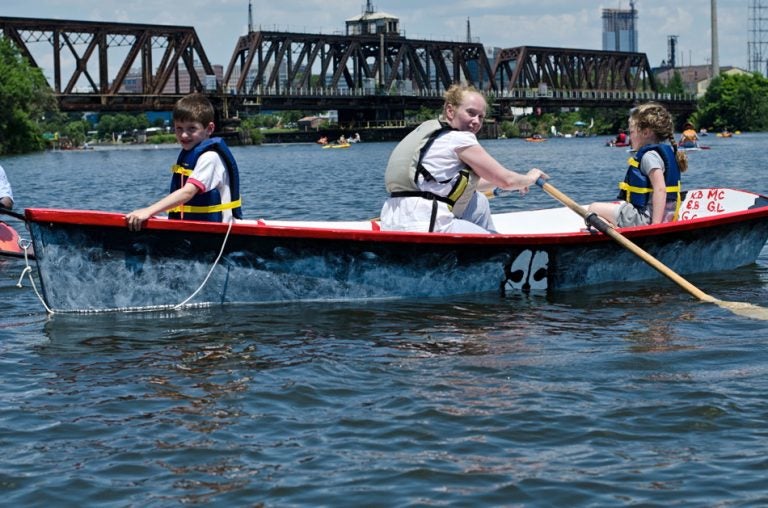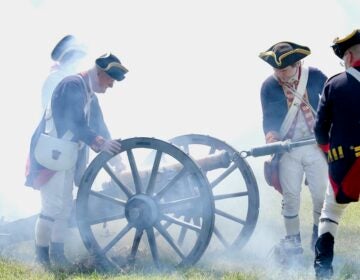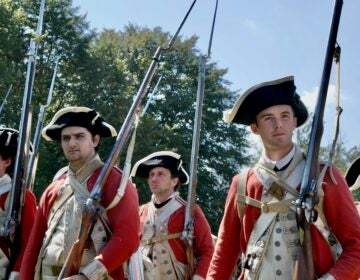Philly kids rescue Washington crossing reenactment from low river levels
When it looked like the annual reenactment of George Washington's daring dash across the Delaware River would be canceled, organizers turned to boats made by Philly kids.
Listen 2:24
Because of low water on the Delaware River, Washington Crossing re-enactors will use boats borrowed from Philadelphia Waterborne, which have a shallower draft than the Durham boats usually used. (Jano Cohen Photography)
A local holiday tradition is back on thanks to a group of hardworking — and woodworking — Philly kids.
Every Christmas Day, the Friends of Washington Crossing Park have reenacted George Washington’s daring dash across the Delaware River, drawing thousands of onlookers. Organizers worried abnormally low water levels would prevent them from crossing by boat this year.
But with the help of six rowboats donated by Philadelphia Waterborne, a nonprofit that teaches boat building to Philadelphia students, the crossing is back on.
Philadelphia Waterborne’s boats are smaller and lighter than the historic Durham boats typically used for the reenactment. Thanks to their nimble design, the rowboats can safely cross the Delaware at its current water levels.
Philadelphia Waterborne is the passion project of former Philly teacher Nicholas Pagon, who visits a rotation of local schools weekly to help students build rowboats. The work encourages students to mix the abstract knowledge they learn in math class with the tangible skills it takes to craft a water-ready vessel.
Since its founding four years ago, Philadelphia Waterborne students at seven schools — Richard Allen Preparatory Charter School, Wissahickon Charter School, Girard College, AIM Academy, George Washington Carver High School of Engineering and Science, St. Peter’s
School, and Maritime Academy Charter School — have built 35 boats.
Pagon happened to be storing six of those boats at Glen Foerd on the Delaware, a riverfront estate in Northeast Philadelphia, not too many miles downriver from where the crossing happened. While hanging around at the boathouse, Pagon met a volunteer with the Friends of Washington Crossing Park. That friendship birthed a partnership when it became clear the Durham boats wouldn’t make it across the Delaware this year.
“Ours should be able to do it,” said Pagon.
Philadelphia Waterborne’s 12-and-a-half-foot rowing skiffs are flat bottomed and draw just a few inches of water, Pagon said.
Each group of students begins work on the boats in November or December. The projects wrap up in April, and students get to launch their vessels in May.
Part of what makes the program effective, Pagon said, is that students get to see their work in action. They get to build something that actually works.
“It gets them really engaged in the project when they realize this is real,” Pagon said.
Now that some of their boats have taken on an even bigger, real-world role, Pagon thinks that message will resonate even more.
“This is just the icing on the cake,” said Pagon. “To see it saving George Washington’s crossing, I think, is fantastic.”
On Christmas night 1776, Washington and his beleaguered troops from the Continental Army crossed the Delaware River and launched a surprise attack on troops stationed in Trenton, New Jersey.
The yearly reenactment of this critical point in the Revolutionary War dates back decades, and attracts between 5,000 and 15,000 spectators, organizers said.
Historians know for certain Washington used Durham boats, said Joseph Capone, executive director of the Friends of Washington Crossing Park. But, he added, they also believe Washington commandeered other vessels to ferry his troops across the Delaware.
Could some of those vessels have been flat-bottomed row boats? Perhaps.
At the very least, this year’s fleet will have some historical significance. Back when re-enactors first staged the Christmas Day crossing 65 years ago, Capone said, they used, you guessed it, rowboats.
WHYY is your source for fact-based, in-depth journalism and information. As a nonprofit organization, we rely on financial support from readers like you. Please give today.





